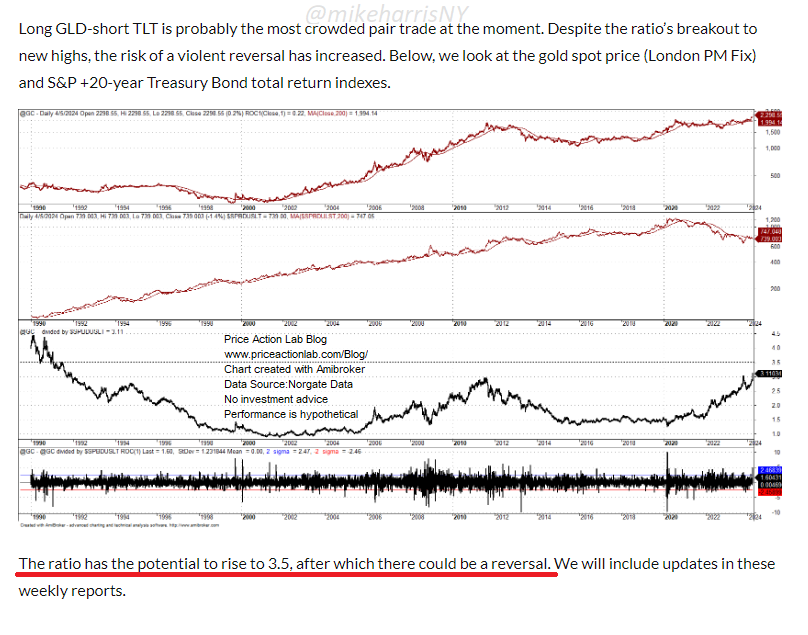I made a mistake this week because I thought two superoptimists were better than one. But this is false because superoptimism is a behavioral bias at the left tail of the cognitive bias distribution and should be avoided not only in finance but also in any other life activity.
In this week’s report for our subscribers, I wrote about the crowded GLD/TLT pair trade and a possible reversal level if the ratio reached 3.5 (based on the spot gold and S&P US Treasury Bond 20+ year total return). This a relevant screenshot from another article.
Therefore, the idea was to wait for a ratio level with an improved reward/risk ratio. My mistake: I listened to two superoptimists talk about the potential for lower inflation and a bond rally. In other words, after thinking that two superoptimists are better than one, I became essentially one. The result was a bet on a quick reversal and a loss. It was my own mistake.
What scares me is that although I had a clear view of the market potential, I paid attention to two superoptimists and lost. This time, I was lucky, and the loss was small because I acted appropriately, but next time it could be large. In my case, after 30 years of experience, acting against my analysis is inconceivable. My mistake: I was following these two superoptimists closely.
Superoptimism about anything is a behavioral bias due to many causes, most of which are unknown. Avoiding superoptimists should be part of risk control in every aspect of life, including the markets. Lately, we see many of those: in technology, geopolitics, and, of course, markets.
The tech superoptimists believe that artificial intelligence will solve all the problems in the world. They do not think for a moment that there is a possibility that things will take a turn for the worse.
Geopolitics superoptimists think that multiple wars will impose a new world order and boost democratic values. They try to find all the excuses why these wars will not end in global annihilation.
Market superoptimists currently argue that inflation will fall, growth and employment will remain strong and the stock market will continue to rise. They see no problems with the rapidly rising US public debt and insist that its level is irrelevant.
Optimism is a bias. It has helped the human race to evolve. On the other hand, superoptimism operates on the tails of cognitive biases and can be catastrophic, as it leaves little room for risk management since actions are extreme.
Being super bullish about any market is as dangerous as being super bearish. Superoptimists rely on the longer-term upward bias for their claims (there are a few accounts on social media with multiple posts every week), but when a 30% drawdown arrives, they have little advice to offer: hold, sell to buy lower, or add to positions? These are part of risk control, and superoptimists seem to have none. Many of those are also in the crypto space, always suggesting their followers “hodl.”
Being an optimist is a normal state. Avoiding superoptimists should be part of risk control. Often, a lack of an exit plan is an indication of superoptimism.
Premium Content
You have immediate access to hundreds of articles when you subscribe. Premium Articles subscribers have immediate access to more than two hundred articles, while All in One subscribers have access to all premium articles, books, premium insights, and market signal content.
Specific disclaimer: This report includes charts that may reference price levels determined by technical and/or quantitative analysis. If market conditions change the price levels or any analysis based on them, we will not update any charts. All charts in this report are for informational purposes only. See the disclaimer for more information.
Disclaimer: No part of the analysis in this blog constitutes a trade recommendation. The past performance of any trading system or methodology is not necessarily indicative of future results. Read the full disclaimer here.
Charting and backtesting program: Amibroker. Data provider: Norgate Data
If you found this article interesting, you may follow this blog via RSS, Email, or Twitter.








